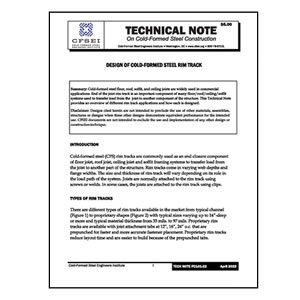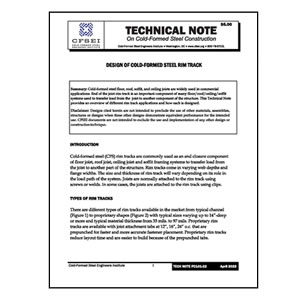Tech Note FC101-22: Design of Cold-Formed Steel Rim Track
$5.00
Summary: Cold-formed steel floor, roof, soffit, and ceiling joists are widely used in commercial applications. End of the joist rim track is an important component of many floor/roof/ceiling/soffit systems used to transfer load from the joist to another component of the structure. This Technical Note provides an overview of different rim track applications and how each is designed.
Disclaimer: Designs cited herein are not intended to preclude the use of other materials, assemblies, structures or designs when these other designs demonstrate equivalent performance for the intended use. CFSEI documents are not intended to exclude the use and implementation of any other design or construction technique.
Related Products

Tech Note B008-20: Basic C-Shaped Wall Stud Behavior
Summary: Although cold-formed steel framing shares some limit states with hot-rolled steel, cold-formed steel framing and specifically C-Shaped studs exhibit unique behaviors when subjected to various loading conditions. This Tech Note gives an overview of those unique behaviors that need to be considered when designing C-Shaped cold-formed steel members.
Disclaimer: Designs cited herein are not intended to preclude the use of other materials, assemblies, structures or designs when these other designs demonstrate equivalent performance for the intended use. CFSEI documents are not intended to exclude the use and implementation of any other design or construction technique.

Tech Note B001-20: How Cold-Formed Steel Framing is Produced
Summary: Cold-formed steel seems like a fairly simple product when you are holding it in your hand, but as you can see, there are many production steps involving things like mining iron ore out of the ground, creating molten steel, furnaces above 2,000°F, reduction mills imparting forces in excess of 100,000 pounds per square inch, and hydrochloric acid cleaning baths before it even reaches the roll forming stage. This Tech Note has provided a basic outline of the processes involved in producing the products you work with daily, be it manufacturing, drafting, designing, engineering, installing or demolishing a building at the end of its life cycle.
Disclaimer: Designs cited herein are not intended to preclude the use of other materials, assemblies, structures or designs when these other designs demonstrate equivalent performance for the intended use. CFSEI documents are not intended to exclude the use and implementation of any other design or construction technique.

Tech Note B005-20: Introduction to Cold-Formed Steel Framing Design Aids
Summary: Both steel industry and manufacturers’ associations provide design aids that assist engineers with the proper application of the cold-formed steel design challenges. Design examples and design aids are essential to educate an engineer in the proper use and design of cold-formed steel members, connections and assemblies. This Tech Note provides an overview of some of the available cold-formed steel framing design aids.
Disclaimer: Designs cited herein are not intended to preclude the use of other materials, assemblies, structures or designs when these other designs demonstrate equivalent performance for the intended use. CFSEI documents are not intended to exclude the use and implementation of any other design or construction technique.

Tech Note L200-09: Roof Framing Anchorage Forces: MWFRS or C&C
Summary: This Technical Note defines the two levels of force and discusses the effects of using Component and Cladding (C&C) loads versus Main Wind Force Resisting System (MWFRS) calculated uplift loads. Design examples are provided to indicate the difference in roof-to-wall anchorage force for either type of load. Mainstream reference standards and quotes from field experts are cited when discussing the appropriate levels for calculating the uplift forces.
Disclaimer: Designs cited herein are not intended to preclude the use of other materials, assemblies, structures or designs when these other designs demonstrate equivalent performance for the intended use. CFSEI documents are not intended to exclude the use and implementation of any other design or construction technique.

Tech Note B004-20: Introduction to Cold-Formed Steel Framing Standards
Summary: The AISI Committee on Framing Standards was established in 1998 with a mission to eliminate regulatory barriers and increase the reliability and cost competitiveness of cold-formed steel framing in residential and light commercial building construction through improved design and installation standards. This Tech Note summarizes the efforts and work products of the Committee.
Disclaimer: Designs cited herein are not intended to preclude the use of other materials, assemblies, structures or designs when these other designs demonstrate equivalent performance for the intended use. CFSEI documents are not intended to exclude the use and implementation of any other design or construction technique.

Tech Note F101-12: Screws for Cold-Formed Steel-To-Wood and Wood-To-Cold-Formed Steel Attachments
Summary: Screws are often used to attach cold-formed steel (CFS) framing to wood members or wood structural panel decking to CFS joists or rafters. The AISI North American Specification for the Design of Cold-Formed Steel Structural Members (AISI S100) provides design equations for screw connection capacity for CFS members. The National Design Specification for Wood Construction (NDS) provides design equations for fastener/connection capacity (nails, wood screws, bolts, etc.) in wood members. The Engineered Wood Association (APA) and the building codes offer several resources for determining the capacity of screw connections attaching wood sheathing. This Tech Note reviews these resources and discusses design and detailing of these fastener connections.
Disclaimer: Designs cited herein are not intended to preclude the use of other materials, assemblies, structures or designs when these other designs demonstrate equivalent performance for the intended use. CFSEI documents are not intended to exclude the use and implementation of any other design or construction technique.

Tech Note S200-20: Design of Cold-Formed Steel Systems for Raised Platforms, Stages and Theater Seating
Summary: It is common for cold-formed steel (CFS) to be used in the construction of raised platforms, stages, and theater seating. It is the intent of the Technical Note to provide an overview of considerations to address when designing such framing, along with some design examples.
Disclaimer: Designs cited herein are not intended to preclude the use of other materials, assemblies, structures or designs when these other designs demonstrate equivalent performance for the intended use. CFSEI documents are not intended to exclude the use and implementation of any other design or construction technique.

Tech Note F602-20: Screw Connections with Other Materials or Gaps Between the Plies
Summary: Screws are the most common connection type for connecting cold-formed steel members to one another. It is also common for gaps to be provided between members in the form of other materials such as gypsum or insulation, but unfortunately, the current standards do not provide clear direction for the design of screwed connections with gaps in the material. This Tech Note will summarize available test data and propose design guidance based on the available test data.
Disclaimer: Designs cited herein are not intended to preclude the use of other materials, assemblies, structures or designs when these other designs demonstrate equivalent performance for the intended use. CFSEI documents are not intended to exclude the use and implementation of any other design or construction technique.

